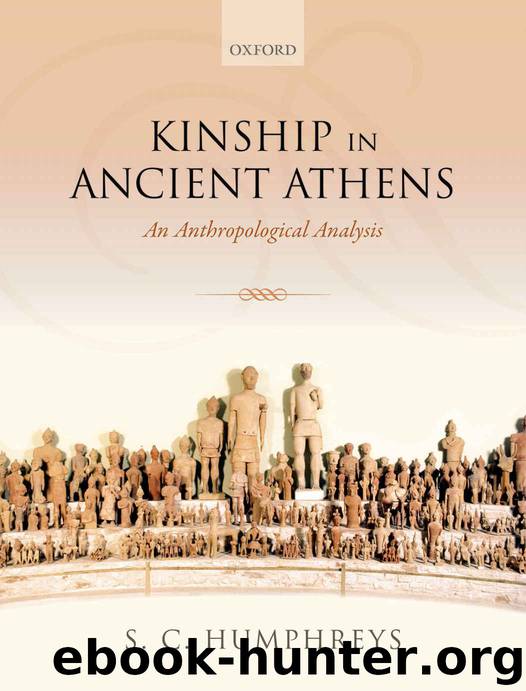Kinship in Ancient Athens by S. C. Humphreys

Author:S. C. Humphreys
Language: eng
Format: azw3
ISBN: 9780198788256
Publisher: Oxford University Press
Published: 2018-11-08T07:00:00+00:00
twenty-one
The Kleisthenic Tribes and Trittyes
Reorganization
Reforms introduced c.507, during the struggle for power after the expulsion of the tyrant Hippias, introduced a new tribal system: ten tribes, named after Attic heroes, each divided into three trittyes. All but the largest trittyes were further subdivided into demes, and every adult male Athenian was required to register in the deme where he lived, ‘deme’ being a common term for a rural settlement, perhaps also for an urban neighbourhood.
So much is agreed; but opinions diverge on the purpose of this restructuring and the sequence of moves by which it was set in place.
Most of the discussion has started from attempts to deduce Kleisthenes’ motives, without first asking what he knew about the distribution of the population of Attika before he started, and trying to reconstruct the sequence of events.1 Let us start, instead, by asking what Kleisthenes’ mental map of Attika might have looked like, and where he would have looked for information about population distribution (cf. Humphreys 2008, 18).
We do not know where Kleisthenes lived, but he had brothers in Alopeke and Xypete,2 and the view of the ‘city’ area that seems to be embodied in his scheme may have a different emphasis from the notion of the ‘Plain’ current in the 560s. Kleisthenes’ city area consists of the Piraeus and Phaleron, the coastal plain, the city, and a rather narrow suburban ring round it. Acharnai and the other villages of the plain north of Athens are ‘inland’, and are not thought of as closely linked to the city.3 This ‘city’ area would presumably be conceptualized by most of its residents in terms of major roads leading out of the city (the Sacred Way, the Acharnai road, the Piraeus road, the Phaleron road, cf. Korres 2009; the names of gates known from the 5th–4th centuries give us an idea of these road names, even though we do not know the course of the wall, if there was one, in 507), physical and sacred landmarks (Kolonos hill, the rivers Ilissos and Kephisos, the gymnasia with their shrines, the sanctuary of Athena Skiras at Phaleron, the Skiron area which served as a ritual boundary between Athens and Eleusis, cf. ch. 20 nn. 32–3), city and suburban quarters (the Kerameikos, in particular, will already have had a distinctive personality), and substantial settlements outside the city, some or all of which will also have been phratry and/or cult centres (Alopeke, Euonymon, Phaleron, Peiraios, Thymaitadai, etc.). Age, class, and gender will have introduced variations into this mixture of sacred, social, and commercial geography, as will the seasons of the year and the days of the month; and there will probably have been a tendency for those who did not live in sacred centres to overestimate their population as a result of only visiting them at festivals. Phratry size could have been ascertained by consulting phratry priests or other leading men, but Kleisthenes and his contemporaries were aware that phratry membership and residence did not always coincide.
Outside the city area, the mental map of the city resident may well have been sketchier.
Download
This site does not store any files on its server. We only index and link to content provided by other sites. Please contact the content providers to delete copyright contents if any and email us, we'll remove relevant links or contents immediately.
| Africa | Americas |
| Arctic & Antarctica | Asia |
| Australia & Oceania | Europe |
| Middle East | Russia |
| United States | World |
| Ancient Civilizations | Military |
| Historical Study & Educational Resources |
Underground: A Human History of the Worlds Beneath Our Feet by Will Hunt(12024)
Sapiens by Yuval Noah Harari(5294)
Navigation and Map Reading by K Andrew(5111)
The Sympathizer by Viet Thanh Nguyen(4305)
Barron's AP Biology by Goldberg M.S. Deborah T(4097)
5 Steps to a 5 AP U.S. History, 2010-2011 Edition (5 Steps to a 5 on the Advanced Placement Examinations Series) by Armstrong Stephen(3689)
Three Women by Lisa Taddeo(3354)
Water by Ian Miller(3127)
The Comedians: Drunks, Thieves, Scoundrels, and the History of American Comedy by Nesteroff Kliph(3039)
Drugs Unlimited by Mike Power(2545)
A Short History of Drunkenness by Forsyth Mark(2233)
The House of Government by Slezkine Yuri(2159)
DarkMarket by Misha Glenny(2158)
And the Band Played On by Randy Shilts(2129)
The Library Book by Susan Orlean(2042)
Revived (Cat Patrick) by Cat Patrick(1963)
The Woman Who Smashed Codes by Jason Fagone(1929)
Birth by Tina Cassidy(1864)
The Absolutely True Diary of a Part-Time Indian by Sherman Alexie(1858)
